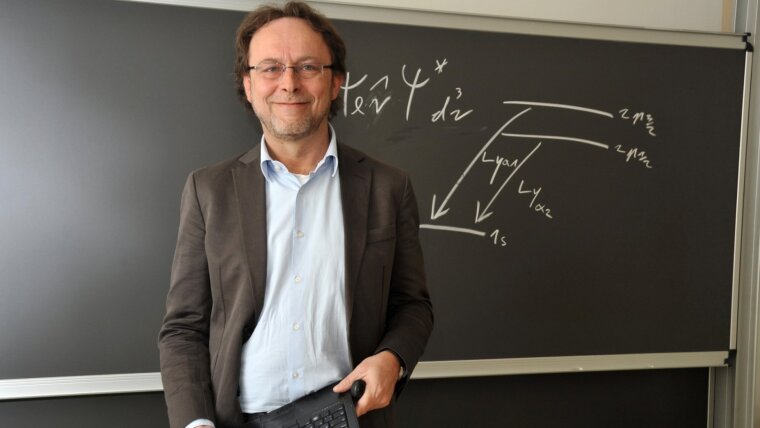
Prof. Dr. Thomas Stöhlker
Image: PrivateProf. Dr. Thomas STÖHLKER
Email: t.stoehlker@uni-jena.de
Phone: +49 3641-9-47600
Prof. Stöhlker is the director of the Helmholtz Institute Jena and the representative of the APPA research branch (Atomic Physics, Plasma Physics, Materials Research) at GSI, Helmholtz Centre for Heavy Ion Research in Darmstadt. He is a member of “From Matter to Materials and Life”, and the speaker of “From Matter to Materials and Life”, both research programmes of the Helmholtz Association.
This group focuses on the exploration of the particle dynamics in the realm of strong and critical Coulomb and photon fields with particle emphasis on Quantum Electrodynamics. For this purpose highly charged ions and strong laser fields and their combination are particularly well suited but require the development of dedicated diagnostics and instrumentation. As examples, within our experimental campaigns various x-ray detection systems such as 2D/3D position-sensitive and energy-dispersive detectors, crystal spectrometers, x-ray CCDs, novel x-ray polarimeters, and micro-calorimeters are getting developed and used as well as ion sources, storage rings, and traps to study ions in intense laser light.
Research Areas
Prof. Stöhlker’s research interests are focused on electron dynamics in strong and extreme fields, with particular emphasis of the effects of quantum electrodynam-ics (QED):
- Experiments on bound-state QED and the atomic structure of few-electron ions at high-Z
- Radiative processes in collisions of relativistic particles (ions and electrons)
- Collision dynamics involving heavy ions
- Light-matter interaction in the strong-field regime
- Polarization phenomena and imagine for hard x-rays
Teaching Fields
Prof. Stöhlker’s teaching is focused on the physics of simple atomic systems, including the atomic structure, atomic collisions, and fundamental aspects such as QED and parity violation. He gives courses and seminars in:
- Key experiments in modern atomic physics
- The interaction of high-energy radiation with matter
- Photonic processes in highly ionized matter
Research Methods
Prof. Stöhlker runs sophisticated setups for photon, x-ray, electron, and ion spectroscopy which are used for the experiments at storage rings, traps and synchrotrons, including:
- X-ray spectrometers of transmission and reflection type (e.g. Lamb shift)
- Micro calorimeters and cryogenic sensors
- Compton polarimetry and imaging
- Particle diagnostic (e.g. Cryogenic Current Comparator)
- X-ray and UV-astrophysics
- Storage and trapping techniques for highly charged ions
Recent Research Results
One- and few-electron ions provide an ideal testing ground for fundamental theories including quantum electro-dynamics (QED) as well as relativity and correlation. As an example for simple one-electron system, a new experiment at the just installed CRYRING@ESR ion storage ring at GSI Darmstadt [1], aims to determine the ground-state Lamb shift in hydrogen-like uranium with an accuracy that substantially exceeds 1% (see e.g. [2]). This will provide the most stringent test of bound-state QED for one-electron systems in the strong field regime approaching the Schwinger limit (1016 V/cm). Based on the application of dedicated, novel high-resolution novel low-temperature x-ray detectors [3], a new experiment has just been performed and the data are currently getting analyzed. Complementary at extreme magnetic fields, substantial progress has been reported for 209Bi82+,80+ where a substantial improvement of the experimental precision has been reported but a still unexplained 7σ deviation from most sophisticated theoretical predictions is found [4].
A further branch of research activities focuses on imaging techniques and polarization studies for hard x- and γ-radiation, based on the position sensitive and energy dispersive, granular x-ray detectors (see e.g. [5]). Experiments utilizing such novel 2D/3D strip or pixel detectors focus on the study of photonic electron transitions and scattering processes in the strong-field domain (characteristic radiation, Rayleigh scattering, electron-bremsstrahlung and recombination radiation) where spin effects are important and provide detailed information about the quantum dynamics in the strong-field domain [6].
[1] M. Lestinsky et al., Eur. Phys. J.-Spec. Top. 225, 797 (2016). linkExternal link
[2] T. Gassner et al., New J. Phys. 20, 073033 (2018). linkExternal link
[3] S. Kraft-Bermuth et al., Atoms 6, 59 (2018). linkExternal link
[4] J. Ullmann et al., Nat. Commun. 8, 15484 (2017). linkExternal link
[5] W. Middents et al., Annalen Der Physik n/a, 2100285 (2021). linkExternal link
[6] Blumenhagen et al., New J. Phys. 18, 103034 (2016). linkExternal link
For further literature please check out:
[7] M. Stapelfeld et al., IEEE Trans. Appl. Supercond. 31, 1 (2021). linkExternal link
[8] M. Kröger et al., Phys. Rev. A 102, 042825 (2020). linkExternal link
[9] D. Winzen et al., Sci. Rep. 11, 9370 (2021). linkExternal link
